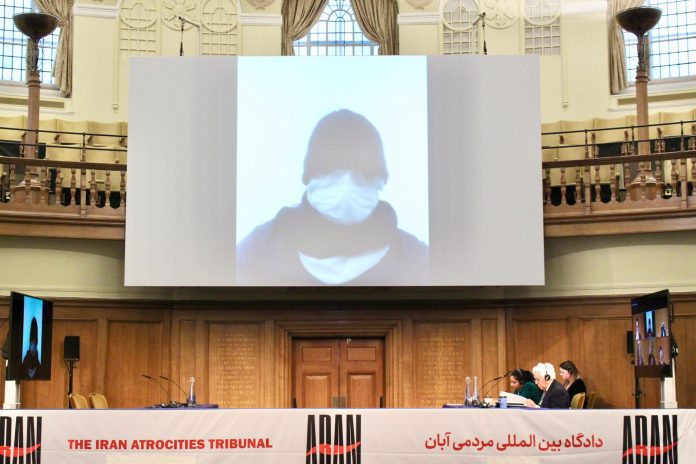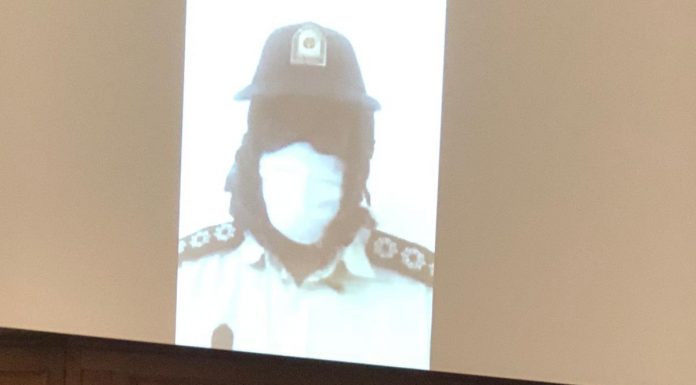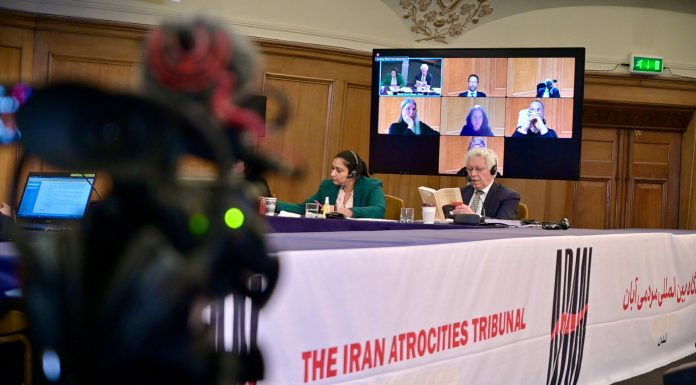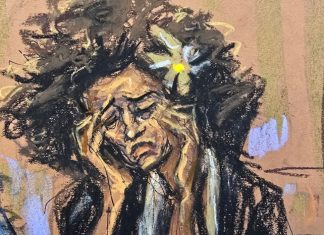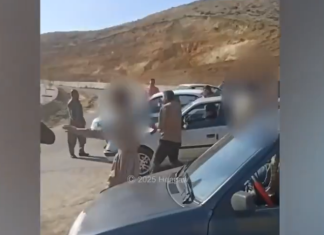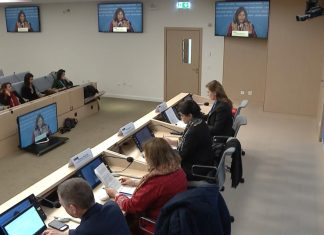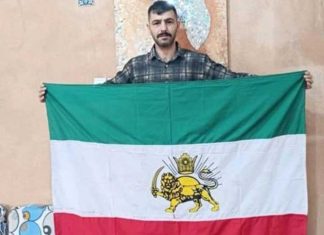By Ahmad Rafat
The Aban Tribunal held its second hearing behind closed doors between Feb. 4 and 6 at the Church House in London. A panel of six judges heard from 22 new witnesses. The court allowed only journalists to attend the proceedings.
[aesop_image img=”https://kayhanlife.com/wp-content/uploads/2022/02/Tribunal-Aban-Feb-22-1.jpeg” panorama=”off” credit=”The Aban Tribunal. February 2022/ FILE PHOTO/KL./” align=”center” lightbox=”off” captionsrc=”custom” captionposition=”left” revealfx=”off” overlay_revealfx=”off”]
The Aban Tribunal has been established to investigate the Iranian authorities’ violent suppression of a wave of nationwide demonstrations in November 2019. The tribunal has been organized by the following non-governmental human rights organizations: the London-based Justice for Iran, the Oslo-based Iran Human Rights (IHR), and the Paris-based Together against the Death Penalty (Ensemble Contre la Peine de mort-ECPM).
SPECIAL REPORT- Iran’s Leader Ordered Crackdown on Unrest: “Do Whatever It Takes to End It”
During the first hearing, held between Nov. 10 and 14, 2021, the judges, headed by Wayne Jordash, heard from 34 witnesses. Mr. Jordash is a British lawyer and a former member of the International Criminal Tribunal for the former Yugoslavia (ICTY).
Other judges on the panel included Elham Saudi, the founder and director of Lawyers for Justice in Libya; Zak Yacoob, a former member of the South Africa Constitutional Court; Nursyahbani Katjasungkana, the Indonesian prosecutor of the Women’s International War Crimes Tribunal on Japan’s Military Sexual Slavery; Colleen Rohan, a former member of the ICTY; and Carla Ferstman, a professor at the University of Essex School of Law.
The Aban Tribunal prosecution team included two lawyers, Hamid Sabi and Regina Paulose.
Iran Accused of “Crimes Against Humanity” at Aban Tribunal in London
The prosecutors had received 600 affidavits from people willing to testify at the Tribunal. After examining each case thoroughly, the prosecutors chose 219 witnesses whose accounts they deemed credible and submitted those testimonies to the panel of judges.
While Tehran made no official response to the first session of the Tribunal back in November, some senior diplomats privately complained to British officials for allowing the Aban Tribunal to be held in London.
During a closed-door meeting with his British counterpart in November, Ali Bagheri Kani, the political deputy at the Iranian Foreign Ministry, complained about the Aban Tribunal.
Hassan Nowrouzi, the deputy chairperson of the Legal and Judicial Committee of the Majlis (Iranian Parliament), also said: “I was one of those who fired shots at people. We killed, so who wants to prosecute us?”
Commenting on Mr. Nowrouzi’s remarks, Hamid Sabi, one of the two prosecutors at the Aban Tribunal, said: “This shows that the Islamic Republic officials believe they are immune from prosecution, something that this tribunal must confront.”
However, a day after the Tribunal concluded its second hearing, Iranian Foreign Ministry spokesperson, Saeed Khatibzadeh, lodged a formal complaint with the UK government, accusing London of being a “hub” for foreign media hostile to Iran and describing the Aban Tribunal as a “theatrical show.”
“A play has actors and a director, and others facilitate the stage,” Mr. Khatibzadeh said during a news conference on Feb. 7. “London has become a center for activities against Iranian people and a venue for creating such toxic atmospheres.”
Hamid Sabi has pointed out that there is no need to get a permit to hold such tribunals in Britain.
Speaking to Kayhan Life about Khatibzadeh’s remarks, Shadi Amin, a director of Justice for Iran, said: “His [Khatibzadeh’s] statement is an absolute sign of fear and anger the outcomes of this Tribunal have created amongst the most high-ranking officials. However, this will not make any disturbance or problem to the process of the Tribunal as we foresaw such reactions. We hope that after the delivery of the final judgment, we will take further legal steps against perpetrators of the November 2019 atrocities.”
The Islamic Republic’s fear and anger stem from the fact that the witnesses at the Tribunal included a commander of the Islamic Revolutionary Guards Corps (IRGC), a former member of the Basij Forces’ Imam Ali Brigade, two Law Enforcement Force (NAJA) officers and a judge. Tehran has been unhappy about the testimony given by the senior IRGC officer, identified by the Aban Tribunal as witness-600.
[aesop_image img=”https://kayhanlife.com/wp-content/uploads/2022/02/Witness-600.jpeg” panorama=”off” credit=”Witness 600. KL./” align=”center” lightbox=”off” captionsrc=”custom” captionposition=”left” revealfx=”off” overlay_revealfx=”off”]
Khatibzadeh is not the only senior Iranian official who has reacted strongly to the testimony of the IRGC officer. Many politicians in conservative and reformist camps have denounced the tribunal and its witnesses.
Speaking to Kayhan Life, Hamid Sabi, one of the two prosecutors at the Aban Tribunal, said: “Testimonies by members of the military are significant, particularly those by an IRGC commander who was in Tehran and witnessed the atrocities and spoke about the direct involvement of [Iran’s Supreme Leader Ayatollah] Ali Khamenei in the decision-making process in November 2019.”
“These testimonies can be a significant factor in the judges’ final verdict on crimes committed against humanity and on Khamenei as the person under whose order these crimes were committed,” Saba added.
A hacktivist group, calling itself Ali’s Justice (“Edalat-e Ali”) recently leaked a secret letter, in which a Tehran deputy prosecutor, Mir Mostafa Seyyed Sharrafi, allegedly mentioned court cases held outside Iran, including the Aban Tribunal and the ongoing trial of Hamid Nouri, an Iranian official detained by the authorities in Sweden since November 2019. Mr. Nouri is accused of playing a key role in the 1988 mass execution of political prisoners while serving as the prosecutor at Karaj Gohardasht Prison.
In the letter, reportedly written on Nov. 13, 2021, Mr. Seyyed Sharrafi allegedly warned that although court proceedings such as the Aban Tribunal are “purely for propaganda” and lack any “legal muscle,” they “enable the European judicial institutions to use the verdicts by these courts of public opinions to detain and prosecute the Islamic Republic officials outside Iran.”
In the letter, Seyyed Sharrafi referred to Hamid Nouri’s case, who was arrested by the authorities when he arrived in Stockholm on Nov. 9, 2019. Nouri’s trial started in August and will continue until spring.
Witness testimonies given in the trial of Nouri and at the Aban Tribunal allegedly implicate Khamenei. The final Council’s Brief (RB.gy/v20saw) submitted to the Aban Tribunal’s judges on Feb. 6 accused 160 senior and mid-level Iranian officials of allegedly committing crimes against humanity.
What was in the eyewitness testimony of the senior IRGC officer at the Aban Tribunal that has angered and worried the Islamic Republic officials?
The officer, identified as witness-600, provided evidence from Tehran via a video link. He gave the court detailed testimony about the clashes between heavily armed security forces and unarmed civilians, alleging that 420 protesters were killed in Tehran and 427 in the southern province of Khuzestan. The officer added that 7,000 people were arrested in Tehran alone during the three days of protest.
“The IRGC has undergone training for crushing civil disobedience for many years,” the officer noted. “The IRGC units had been put on alert in the week preceding protests over the gasoline price hike [in November 2019].”
The most significant part of the IRGC officer’s testimony was about two influential state officials close to Khamanei who had, on the behest of the leader, given the commander of the IRGC “the order to fire [at protesters] and end the crisis quickly.” The two-state officials were allegedly Khalafi, the chief of staff of the Office of the Supreme Leader, and Vahid Haghighian, who is reportedly one of the most influential and closest advisors to Khamanei. Under the Islamic Republic Constitution, only the commander-in-chief, namely Khamanei, has that authority.
OPINION: IRGC’s Massive Control Over Iranian Politics and Economy
The court identified the two Law Enforcement Force officers who testified at the Aban Tribunal as witness-418 and witness-601. Both officers noted that the order to fire on protesters “came from senior officials and the leadership, who wanted to see a quick end to the protests.”
“They did not want the Law Enforcement Force units to use Kalashnikov rifles and standard issued guns, so the bullets could not be traced,” Witness-418 testified.
[aesop_image img=”https://kayhanlife.com/wp-content/uploads/2022/02/Witness-418.jpeg” panorama=”off” credit=”Witness 418. KL./” align=”center” lightbox=”off” captionsrc=”custom” captionposition=”left” revealfx=”off” overlay_revealfx=”off”]
“Isfahan’s Bloody Friday”: Iran Cracks Down On Protests Over Water Shortage
Although Witness-601’s face was hidden during video testimony, the badges on his uniform showed that he was a first lieutenant in the police force. He repeatedly pointed out that there was no need for security and police forces to shoot people in the torso and upper body, given that protesters were not carrying weapons of any kind. However, he and police units were ordered to fire into the crowd to “end the protest.”
[aesop_image img=”https://kayhanlife.com/wp-content/uploads/2022/02/Tribunal-Aban-Feb-22-4.jpeg” panorama=”off” align=”center” lightbox=”off” captionsrc=”custom” captionposition=”left” revealfx=”off” overlay_revealfx=”off”]
[aesop_image img=”https://kayhanlife.com/wp-content/uploads/2022/02/Witness-601.jpeg” panorama=”off” credit=”Witness 601. KL./” align=”center” lightbox=”off” captionsrc=”custom” captionposition=”left” revealfx=”off” overlay_revealfx=”off”]
Witness-458, a member of the Basij Forces’ Imam Ali Brigade, also testified that the order to use live ammunition to fire at unarmed protesters came from “high up” in the chain of command. He alleged foreign fighters were among the forces brutalizing the protesters. According to him, members of the Iraqi Popular Mobilization Forces (PMF) and Liwa Fatemiyoun were among the security forces shooting the protesters.
[aesop_image img=”https://kayhanlife.com/wp-content/uploads/2022/02/Witness-458.jpeg” panorama=”off” credit=”Witness 458. KL./” align=”center” lightbox=”off” captionsrc=”custom” captionposition=”left” revealfx=”off” overlay_revealfx=”off”]
The PMF — also known as the People’s Mobilization Committee (PMC) and the Popular Mobilization Units (PMU) — is an Iraqi state-sponsored umbrella organization consisting of some 40 militias, mostly Shia Muslim, but also include Sunni Muslim, Christian, and Yazidi groups.
Liwa Fatemiyoun (Fatemiyoun Brigade) is the Shia Afghan forces fighting in Syria under the auspices of the IRGC.
New Database Tracks Iran’s Human Rights Violations Since 1979
The IRGC commander (witness-600) also testified that Iraqi, Yemeni, and Syrian militias at Shahid Anaraki military base (in Varamin) and Shahid Pazouki military base (in Semnan) were mobilized for crushing the protests.

